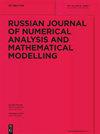纳米致敏剂质子放射治疗中辐照空间优化的数学建模
IF 0.6
4区 数学
Q4 MATHEMATICS, APPLIED
Russian Journal of Numerical Analysis and Mathematical Modelling
Pub Date : 2023-10-01
DOI:10.1515/rnam-2023-0023
引用次数: 0
摘要
摘要:本文提出了一个空间分布的数学模型,模拟了非侵袭性肿瘤在使用非放射性肿瘤特异性纳米增敏剂的分形质子治疗下的生长过程。每次照射前静脉注射纳米增敏剂,通过与治疗性质子的连锁反应增加局部沉积剂量。模型模拟表明,使用纳米增敏剂可以提高治疗效果。然而,为了符合正常的损伤限制,必须减少肿瘤中沉积的能量,因此它们的效果受到限制。伴随治疗的肿瘤微血管的正常化也损害了纳米致敏剂的作用,因为它损害了纳米致敏剂在肿瘤中的流入。结果表明,在保证肿瘤内总剂量不变的情况下,照射空间优化可增加肿瘤细胞的单次照射损伤。然而,由于两次照射之间肿瘤细胞再生的影响,最终可能不会导致治疗效果的整体提高,就剩余活肿瘤细胞数量的最小化而言。因此,通过清除代谢被剥夺的肿瘤细胞来更快地抑制血管生成可能是使肿瘤细胞再生最小化的有效方法。这种方法是有效的,尽管它也会导致纳米致敏剂进入肿瘤的供应减少。本文章由计算机程序翻译,如有差异,请以英文原文为准。
Mathematical modelling for spatial optimization of irradiation during proton radiotherapy with nanosensitizers
Abstract A spatially distributed mathematical model is presented that simulates the growth of a non-invasive tumour undergoing treatment by fractionated proton therapy with the use of non-radioactive tumour-specific nanosensitizers. Nanosensitizers are injected intravenously before each irradiation to increase the locally deposited dose via a chain of reactions with therapeutic protons. Modelling simulations show that the use of nanosensitizers allows increasing treatment efficacy. However, their effect is restricted by the necessity of decreasing the energy deposited in tumour in order to comply to the normal damage restrictions. Normalization of tumour microvasculature that accompanies the treatment, also compromises nanosensitizers effect as it impairs their inflow in tumour. It is shown that spatial optimization of irradiation, with conservation of total dose deposited in tumour, can increase tumour cell damage for each single irradiation. However, eventually it may not lead to the overall increase of treatment efficacy, in terms of minimization of the number of remaining viable tumour cells, due to the influence of tumour cell repopulation between irradiations. It is suggested that an efficient way towards minimization of tumour cell repopulation may be the faster suppression of angiogenesis by eradication of metabolically deprived tumour cells. This method can be efficient even despite the fact that it would also cause the decrease of supply of nanosensitizers into the tumour.
求助全文
通过发布文献求助,成功后即可免费获取论文全文。
去求助
来源期刊
CiteScore
1.40
自引率
16.70%
发文量
31
审稿时长
>12 weeks
期刊介绍:
The Russian Journal of Numerical Analysis and Mathematical Modelling, published bimonthly, provides English translations of selected new original Russian papers on the theoretical aspects of numerical analysis and the application of mathematical methods to simulation and modelling. The editorial board, consisting of the most prominent Russian scientists in numerical analysis and mathematical modelling, selects papers on the basis of their high scientific standard, innovative approach and topical interest.
Topics:
-numerical analysis-
numerical linear algebra-
finite element methods for PDEs-
iterative methods-
Monte-Carlo methods-
mathematical modelling and numerical simulation in geophysical hydrodynamics, immunology and medicine, fluid mechanics and electrodynamics, geosciences.

 求助内容:
求助内容: 应助结果提醒方式:
应助结果提醒方式:


